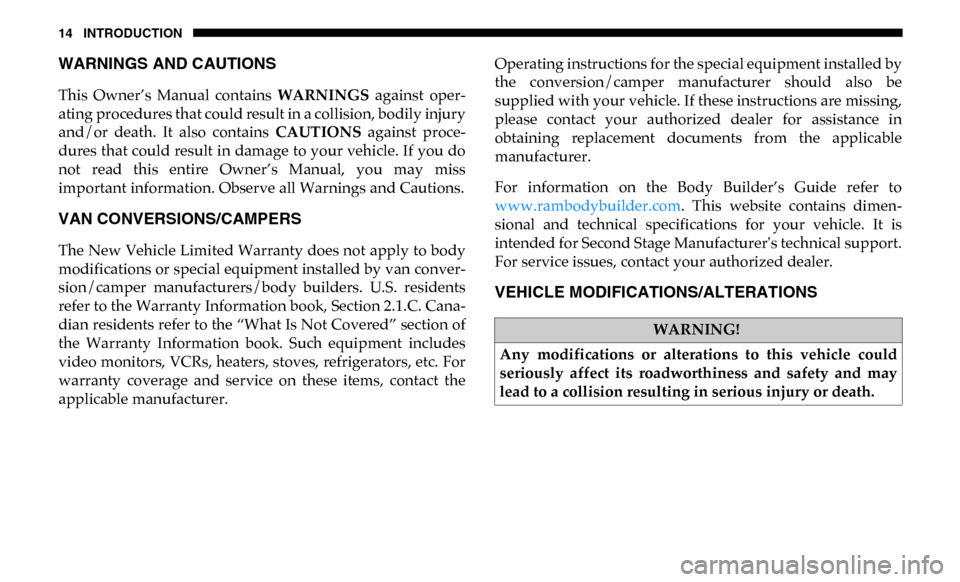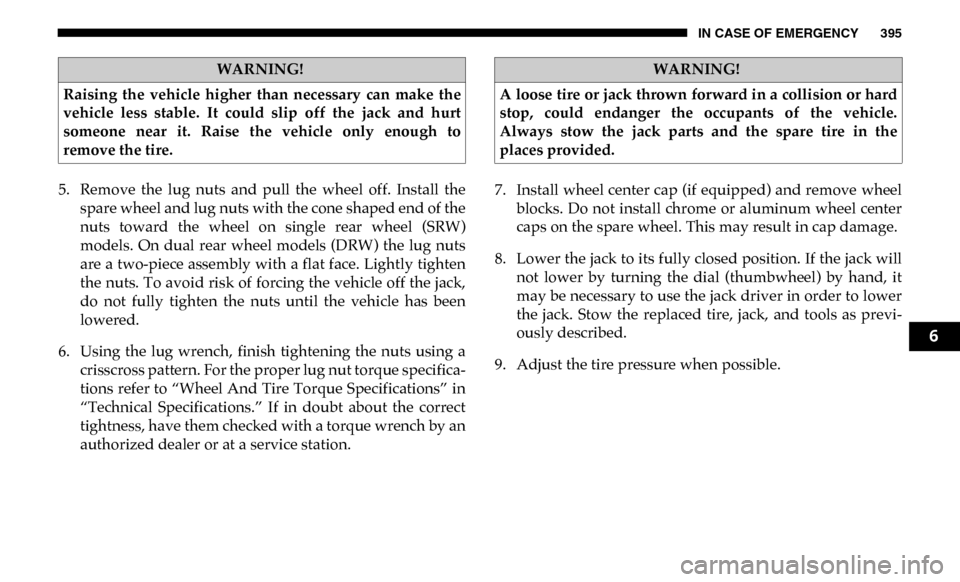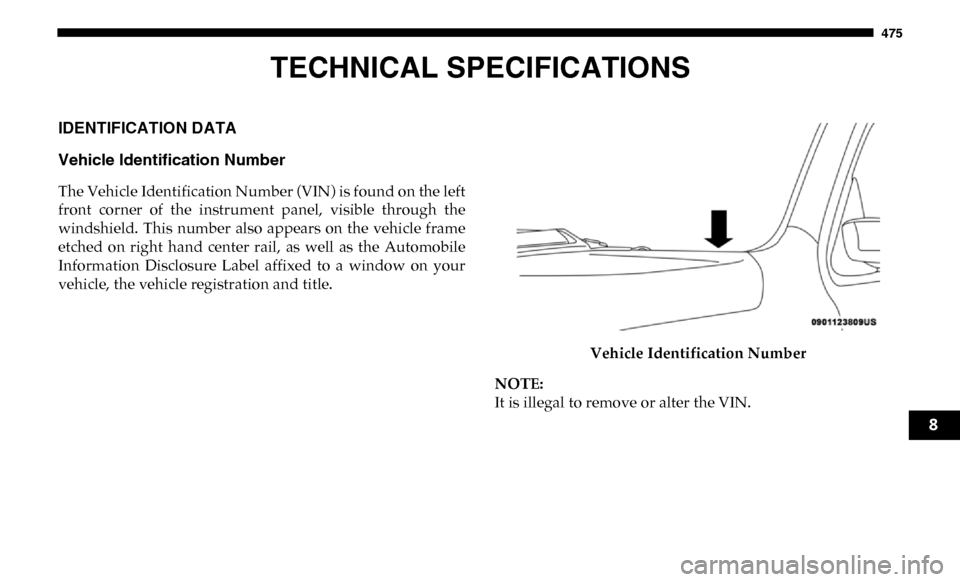technical specifications Ram 3500 Chassis Cab 2019 Owner's Manual
[x] Cancel search | Manufacturer: RAM, Model Year: 2019, Model line: 3500 Chassis Cab, Model: Ram 3500 Chassis Cab 2019Pages: 607, PDF Size: 10.72 MB
Page 3 of 607

TABLE OF CONTENTS
1
2
3
4
5
6
7
8
9
10
11
1 INTRODUCTION ................................................................................................................................................................................. 122 GETTING TO KNOW YOUR VEHICLE ......................................................................................................................................... 15
3 GETTING TO KNOW YOUR INSTRUMENT PANEL .............................................................................................................. 123
4 SAFETY ................................................................................................................................................................................................. 161
5 STARTING AND OPERATING ...................................................................................................................................................... 244
6 IN CASE OF EMERGENCY .............................................................................................................................................................. 366
7 SERVICING AND MAINTENANCE ............................................................................................................................................. 410
8 TECHNICAL SPECIFICATIONS .................................................................................................................................................... 475
9 MULTIMEDIA .................................................................................................................................................................................... 487
10 CUSTOMER ASSISTANCE ............................................................................................................................................................. 585
11 INDEX .................................................................................................................................................................................................... 590
Page 11 of 607

9
DEALER SERVICE ........................................................... 417
Engine Oil — Gas Engine .......................................... 418
Engine Oil Filter ......................................................... 419
Engine Air Cleaner Filter ......................................... 420
Air Conditioner Maintenance ................................. 421
Accessory Drive Belt Inspection ................................ 426
Body Lubrication ....................................................... 428
Windshield Wiper Blades ......................................... 428
Exhaust System ........................................................... 431
Cooling System ........................................................... 433
Brake System ............................................................... 438
Automatic Transmission ............................................ 439
Rear Axle And 4x4 Front Driving Axle Fluid
Level .......................................................................... 442
Transfer Case ............................................................... 444
HOISTING ......................................................................... 444
TIRES .................................................................................. 444
Tire Safety Information ............................................ 444
Tires — General Information ................................... 454
Tire Types ..................................................................... 460
Spare Tires — If Equipped ..................................... 461
Wheel And Wheel Trim Care ................................. 464
Tire Chains (Traction Devices) ................................. 465
Tire Rotation Recommendations ............................... 466
DEPARTMENT OF TRANSPORTATION UNIFORM
TIRE QUALITY GRADES ...............................................468
Treadwear .....................................................................469
Traction Grades............................................................ 469
Temperature Grades ................................................... 469
STORING THE VEHICLE .............................................470
BODYWORK ......................................................................470
Protection From Atmospheric Agents ....................470
Body And Underbody Maintenance .........................471
Preserving The Bodywork .......................................... 471
INTERIORS .......................................................................472
Seats And Fabric Parts ................................................472
Plastic And Coated Parts ............................................473
Leather Parts.................................................................474
Glass Surfaces ..............................................................474
TECHNICAL SPECIFICATIONS
IDENTIFICATION DATA ...............................................475
Vehicle Identification Number ................................. 475
BRAKE SYSTEM ...............................................................476
Hydraulic Brake Assist ...............................................476
WHEEL AND TIRE TORQUE SPECIFICATIONS .....476
Torque Specifications ................................................477
Page 16 of 607

14 INTRODUCTION
WARNINGS AND CAUTIONS
This Owner’s Manual contains WARNINGS against oper-
ating procedures that could result in a collision, bodily injury
and/or death. It also contains CAUTIONS against proce -
dures that could result in damage to your vehicle. If you do
not read this entire Owner’s Manual, you may miss
important information. Observe all Warnings and Cautions.
VAN CONVERSIONS/CAMPERS
The New Vehicle Limited Warranty does not apply to body
modifications or special equipment installed by van conver -
sion/camper manufacturers/body builders. U.S. residents
refer to the Warranty Information book, Section 2.1.C. Cana -
dian residents refer to the “What Is Not Covered” section of
the Warranty Information book. Such equipment includes
video monitors, VCRs, heaters, stoves, refrigerators, etc. For
warranty coverage and service on these items, contact the
applicable manufacturer. Operating instructions for the special equipment installed by
the conversion/camper manufacturer should also be
supplied with your vehicle. If these instructions are missing,
please contact your authorized dealer for assistance in
obtaining replacement documents from the applicable
manufacturer.
For information on the Body Builder’s Guide refer to
www.rambodybuilder.com
. This website contains dimen -
sional and technical specifications for your vehicle. It is
intended for Second Stage Manufacturer's technical support.
For service issues, contact your authorized dealer.
VEHICLE MODIFICATIONS/ALTERATIONS
WARNING!
Any modifications or alterations to this vehicle could
seriously affect its roadworthiness and safety and may
lead to a collision resulting in serious injury or death.
Page 253 of 607

STARTING AND OPERATING 251
ENGINE BLOCK HEATER — IF EQUIPPED
The engine block heater warms the engine, and permits
quicker starts in cold weather. Connect the cord to a stan-
dard 110-115 Volt AC electrical outlet with a grounded,
three-wire extension cord.
Gasoline Engine Only
The engine block heater cord is routed through the grille by
the right front tow hook.
It includes a removable cap that is secured by a tethered
strap. It also has a c-clip that is used for storage when not in
use for the Winter months. During Winter months, remove
the heater cord wiring assembly from itself on the c-clip.
The engine block heater must be plugged in at least one hour
to have an adequate warming effect on the engine.
ENGINE BREAK-IN RECOMMENDATIONS
A long break-in period is not required for the engine and
drivetrain (transmission and axle) in your vehicle.
Drive moderately during the first 300 miles (500 km). After
the initial 60 miles (100 km), speeds up to 50 or 55 mph (80 or
90 km/h) are desirable.
While cruising, brief full-throttle acceleration within the
limits of local traffic laws contributes to a good break-in.
Wide-open throttle acceleration in low gear can be detri -
mental and should be avoided.
The engine oil installed in the engine at the factory is a
high-quality energy conserving type lubricant. Oil changes
should be consistent with anticipated climate conditions
under which vehicle operations will occur. For the recom -
mended viscosity and quality grades, refer to “Fluids And
Lubricants” in “Technical Specifications”.
WARNING!
Remember to disconnect the engine block heater cord
before driving. Damage to the 110-115 Volt electrical
cord could cause electrocution.
CAUTION!
Never use Non-Detergent Oil or Straight Mineral Oil in
the engine or damage may result.
5
Page 286 of 607

284 STARTING AND OPERATING
NOTE:
• Increased noise levels at the end of the steering wheeltravel are considered normal and do not indicate that there
is a problem with the power steering system.
• Upon initial start-up in cold weather, the power steering pump may make noise for a short amount of time. This is
due to the cold, thick fluid in the steering system. This
noise should be considered normal, and it does not in any
way damage the steering system.
Power Steering Fluid Check
Checking the power steering fluid level at a defined service
interval is not required. The fluid should only be checked if
a leak is suspected, abnormal noises are apparent, and/or
the system is not functioning as anticipated. Check fluid level when the engine is cold and off. Coordinate inspection
efforts through an authorized dealer.
If necessary, add fluid to restore to the proper indicated
level. With a clean cloth, wipe any spilled fluid from all
surfaces. Refer to “Fluids And Lubricants” in “Technical
Specifications” for further information.
CAUTION!
Prolonged operation of the steering system at the end of
the steering wheel travel will increase the steering fluid
temperature and it should be avoided when possible.
Damage to the power steering pump may occur.
WARNING!
Fluid level should be checked on a level surface and with
the engine off to prevent injury from moving parts and
to ensure accurate fluid level reading. Do not overfill.
Use only manufacturer's recommended power steering
fluid.
CAUTION!
Do not use chemical flushes in your power steering
system as the chemicals can damage your power steering
components. Such damage is not covered by the New
Vehicle Limited Warranty.
Page 397 of 607

IN CASE OF EMERGENCY 395
5. Remove the lug nuts and pull the wheel off. Install thespare wheel and lug nuts with the cone shaped end of the
nuts toward the wheel on single rear wheel (SRW)
models. On dual rear wheel models (DRW) the lug nuts
are a two-piece assembly with a flat face. Lightly tighten
the nuts. To avoid risk of forcing the vehicle off the jack,
do not fully tighten the nuts until the vehicle has been
lowered.
6. Using the lug wrench, finish tightening the nuts using a crisscross pattern. For the proper lug nut torque specifica -
tions refer to “Wheel And Tire Torque Specifications” in
“Technical Specifications.” If in doubt about the correct
tightness, have them checked with a torque wrench by an
authorized dealer or at a service station. 7. Install wheel center cap (if equipped) and remove wheel
blocks. Do not install chrome or aluminum wheel center
caps on the spare wheel. This may result in cap damage.
8. Lower the jack to its fully closed position. If the jack will not lower by turning the dial (thumbwheel) by hand, it
may be necessary to use the jack driver in order to lower
the jack. Stow the replaced tire, jack, and tools as previ -
ously described.
9. Adjust the tire pressure when possible.
WARNING!
Raising the vehicle higher than necessary can make the
vehicle less stable. It could slip off the jack and hurt
someone near it. Raise the vehicle only enough to
remove the tire.WARNING!
A loose tire or jack thrown forward in a collision or hard
stop, could endanger the occupants of the vehicle.
Always stow the jack parts and the spare tire in the
places provided.
6
Page 441 of 607

SERVICING AND MAINTENANCE 439
Automatic Transmission
Selection Of Lubricant
It is important to use the proper transmission fluid to ensure
optimum transmission performance and life. Use only the
manufacturer’s specified transmission fluid. Refer to “Fluids
And Lubricants” in “Technical Specifications”. It is
important to maintain the transmission fluid at the correct
level using the recommended fluid. No chemical flushes
should be used in any transmission; only the approved lubri-
cant should be used. Special Additives
The manufacturer strongly recommends against using any
special additives in the transmission. Automatic Transmis
-
sion Fluid (ATF) is an engineered product and its perfor -
mance may be impaired by supplemental additives.
Therefore, do not add any fluid additives to the transmis -
sion. The only exception to this policy is the use of special
dyes for diagnosing fluid leaks in six-speed transmissions.
Avoid using transmission sealers as they may adversely
affect seals.
• Overfilling the brake fluid reservoir can result in
spilling brake fluid on hot engine parts, causing the
brake fluid to catch fire. Brake fluid can also damage
painted and vinyl surfaces, care should be taken to
avoid its contact with these surfaces.
• Do not allow petroleum based fluid to contaminate the brake fluid. Brake seal components could be damaged,
causing partial or complete brake failure. This could
result in a collision.
WARNING! (Continued)CAUTION!
Using a transmission fluid other than the manufacturer’s
recommended fluid may cause deterioration in
transmission shift quality and/or torque converter
shudder, and (for six-speed transmissions) will require
more frequent fluid and filter changes. Refer to “Fluids
And Lubricants” in “Technical Specifications” for fluid
specifications.
7
Page 446 of 607

444 SERVICING AND MAINTENANCE
Transfer Case
Selection Of Lubricant
Use only the manufacturer's recommended fluid. Refer to
“Fluids And Lubricants” in “Technical Specifications” for
further information.
Fluid Level Check
This fluid level can be checked by removing the filler plug.
The fluid level should be to the bottom edge of the filler plug
hole with the vehicle in a level position.
Drain And Refill
Refer to the “Maintenance Plan” in this section for the proper
maintenance intervals.
HOISTING
A conventional floor jack may be used at the jacking loca-
tions. Refer to the graphics that show jacking locations.
However, a floor jack or frame hoist must never be used on
any other parts of the underbody.
TIRES
Tire Safety Information
Tire safety information will cover aspects of the following
information: Tire Markings, Tire Identification Numbers,
Tire Terminology and Definitions, Tire Pressures, and Tire
Loading. CAUTION!
Never use a floor jack directly under the differential housing of
a loaded truck or damage to your vehicle may result.
Page 477 of 607

475
TECHNICAL SPECIFICATIONS
IDENTIFICATION DATA
Vehicle Identification Number
The Vehicle Identification Number (VIN) is found on the left
front corner of the instrument panel, visible through the
windshield. This number also appears on the vehicle frame
etched on right hand center rail, as well as the Automobile
Information Disclosure Label affixed to a window on your
vehicle, the vehicle registration and title.Vehicle Identification Number
NOTE:
It is illegal to remove or alter the VIN.
8
Page 478 of 607

476 TECHNICAL SPECIFICATIONS
BRAKE SYSTEM
If power assist is lost for any reason (for example, repeated
brake applications with the engine off), the brakes will still
function. However, you will experience a substantial
increase in braking effort to stop the vehicle.
If either the front or rear hydraulic system loses normal
braking capability, the remaining system will still function
with some loss of overall braking effectiveness. This will be
evident by increased pedal travel during application, greater
pedal force required to slow or stop, and activation of the
“Brake Warning Light” and the “ABS Warning Light” (if
equipped) during brake use.
The brake system power assist is provided by a hydro-boost
unit which shares fluid with the power steering system. You
may experience some clicking or hissing noises from the
hydro-boost system during hard braking conditions.
NOTE:
Under cold temperatures, pedal effort will be higher than
normal until the power steering fluid reaches operating
temperature.
Hydraulic Brake Assist
The brake system power assist is provided by a hydro-boost
unit which shares fluid with the power steering system. You
may experience some clicking or hissing noises from the
hydro-boost system during hard braking conditions.
NOTE:
Under cold temperatures, pedal effort will be higher than
normal until the power steering fluid reaches operating
temperature.
WHEEL AND TIRE TORQUE SPECIFICATIONS
Proper lug nut/bolt torque is very important to ensure that
the wheel is properly mounted to the vehicle. Any time a
wheel has been removed and reinstalled on the vehicle, the
lug nuts/bolts should be torqued using a properly calibrated
torque wrench using a high quality six sided (hex) deep wall
socket.